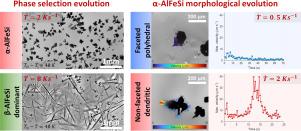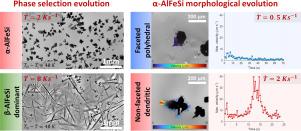探讨耐杂质再生铝合金金属间化合物的形态演化和相选择机制
IF 9.3
1区 材料科学
Q1 MATERIALS SCIENCE, MULTIDISCIPLINARY
引用次数: 0
摘要
富铁金属间化合物(IMCs)是二次铝合金再循环中的一个长期挑战。尽管进行了大量的研究工作,主要是通过凝固后的研究,但在高铁(>1>1 wt.%)、再生铝合金中控制IMC相选择的机制,以及如何控制它们以促进更良性的IMC物质和/或形态,仍然知之甚少。这给耐铁合金的成分和工艺设计带来了障碍。在本文中,我们提出了一个系统的实时研究IMC形成,相选择和形态演变的回收3xx系列铝合金铁浓度升高(高达2.5 wt%),使用原位同步加速器x射线摄影。结合热力学模拟,我们开发了一种可靠估计初级αα-AlFeSi和ββ-AlFeSi IMCs的地层温度的方法,并直接揭示了它们的形成顺序和动力学。与基于低含铁(<<0.6 wt%)原生合金的普遍假设相反,我们发现,在含铁浓度较高的再生合金中,冷却速度的增加显著促进了更具各向异性的ββ-AlFeSi的形成(而不是更致密的αα-AlFeSi),然而,缓慢冷却可以完全抑制这种形成。我们提出了溶质抑制机制如何在动力学上控制αα/ββ IMC相演化。进一步,我们揭示并量化了αα-AlFeSi从多面多面体到非多面近等轴枝晶形态的多面到无面枝晶形态的转变。这种转变是由凝固速度和局部IMC/液体界面处的液体过冷之间的相互作用决定的。这项研究为如何利用凝固条件来改善高含铁回收合金的显微组织控制提供了见解。本文章由计算机程序翻译,如有差异,请以英文原文为准。


Probing the mechanisms of morphological evolution and phase selection of intermetallic compounds for impurity-tolerant processing of recycled Al alloys
Fe-rich intermetallic compounds (IMCs) are a persistent challenge in the recirculation of secondary aluminium alloys. Despite significant research effort, largely via post-solidification studies, the mechanisms governing IMC phase selection in higher-Fe ( wt.%), recycled Al alloys and how they can be controlled to facilitate more benign IMC species and/or morphologies remain poorly understood. This creates barriers to compositional and process design for more Fe-tolerant alloys. In this paper, we present a systematic real-time investigation of IMC formation, phase selection and morphological evolution in recycled 3xx series Al alloys with elevated Fe concentrations (up to 2.5 wt%), using in situ synchrotron X-ray radiography. Coupled with thermodynamic simulations, we develop a method to reliably estimate the formation temperatures of primary -AlFeSi and -AlFeSi IMCs, and show direct insights into their formation sequence and kinetics. Contrary to widely held assumptions based on low Fe-containing (0.6 wt%) primary alloys, we show that in recycled alloys containing higher Fe concentrations, increased cooling rate significantly promotes the formation of the more anisotropic -AlFeSi (over the more compact -AlFeSi), which however can be fully suppressed at slow cooling. We propose how a solute-suppression mechanism kinetically controls the / IMC phase evolution. Further, we reveal and quantify a faceted-to-non-faceted morphological transition of -AlFeSi from a faceted polyhedral to non-faceted near-equiaxed dendritic morphology. This transition is governed by an interplay between solidification velocity and liquid undercooling at the local IMC/liquid interfaces. This study provides insights into how solidification conditions may be leveraged to improve microstructural control in high Fe-containing recycled alloys.
求助全文
通过发布文献求助,成功后即可免费获取论文全文。
去求助
来源期刊

Acta Materialia
工程技术-材料科学:综合
CiteScore
16.10
自引率
8.50%
发文量
801
审稿时长
53 days
期刊介绍:
Acta Materialia serves as a platform for publishing full-length, original papers and commissioned overviews that contribute to a profound understanding of the correlation between the processing, structure, and properties of inorganic materials. The journal seeks papers with high impact potential or those that significantly propel the field forward. The scope includes the atomic and molecular arrangements, chemical and electronic structures, and microstructure of materials, focusing on their mechanical or functional behavior across all length scales, including nanostructures.
 求助内容:
求助内容: 应助结果提醒方式:
应助结果提醒方式:


